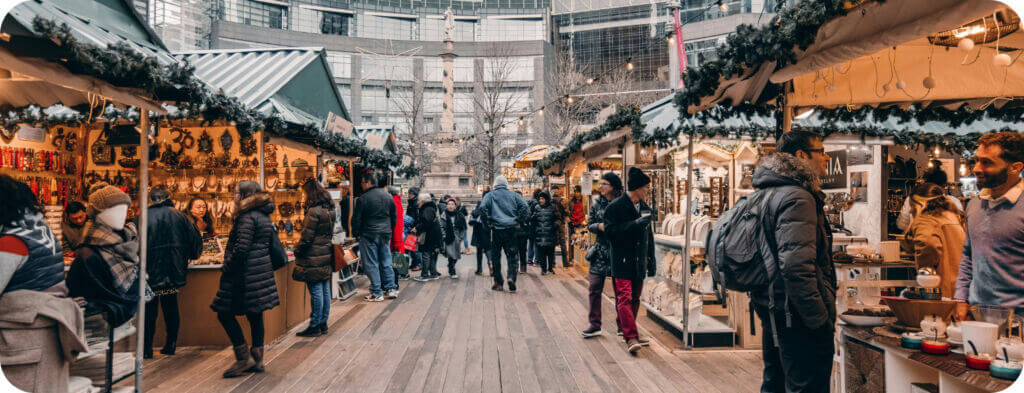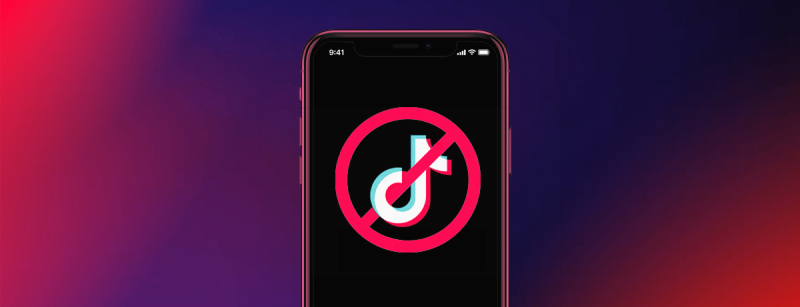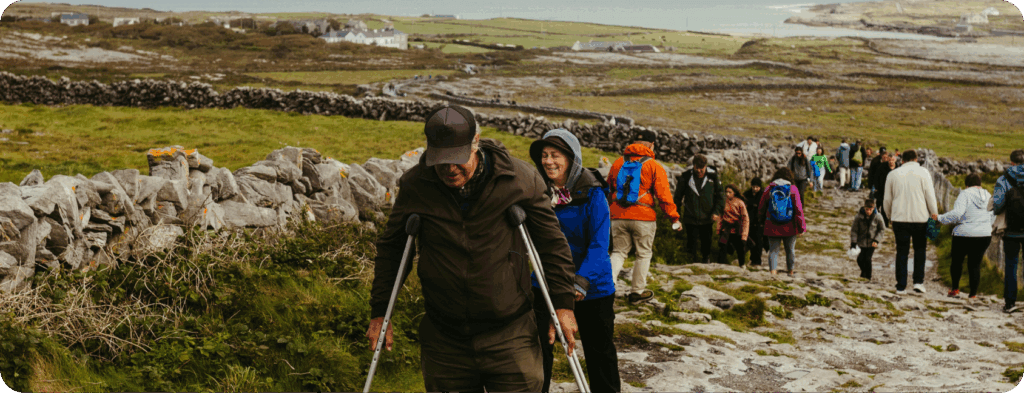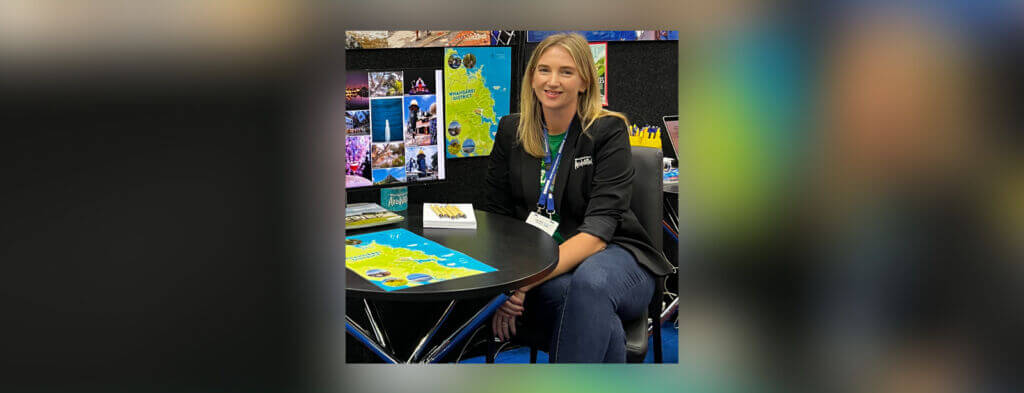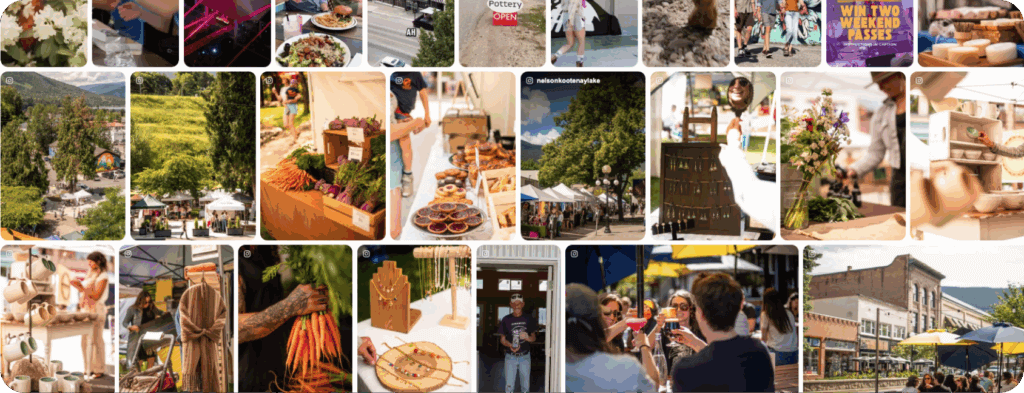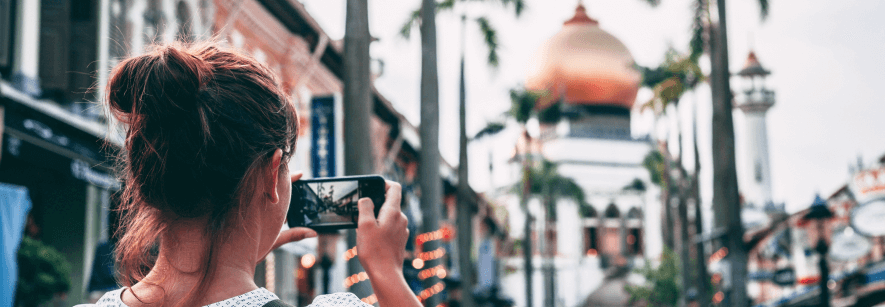
One thing that all destination marketers know is that having an authentic social media strategy is crucial to making audiences feel connected to your brand.
Good storytelling on social media can bring people closer together, which is why it’s imperative for a DMO’s (destination marketing organization) digital marketing plans to prioritize daily thoughtful experiences and conversations on social media.
Planning your social marketing strategy for the coming months or even next year? Here are a few of the latest social media trends and high-performing favorites worth doubling down on.
1. User-generated storytelling trumps traditional advertising
Travelers can sense when something isn’t authentic, especially in our hyper-connected world where user photos, reviews, and hashtags are pre-baked into the travel planning process. And with the recent explosion of AI, this authenticity is more critical than ever.
Before making decisions, travelers tend to take a multi-touch approach to ensure their vacation experience is 100% as advertised. In fact, 79% of people say user-generated content (UGC) has had a highly effective impact in their decisions. (Stackla, 2020)
For today’s traveler, anything less than authentic will turn them off from your marketing. In 2025, we’ll likely see user-generated content and creator-generated content continue to dominate the content marketing plans of brands across industries–but especially in destination marketing.
2. Generative AI is changing the game, but proceed with caution
Since it launched in 2022, we’ve seen ChatGPT explode in popularity. Early adopters were quick to find ways it could help them save time on mundane, time-intensive tasks like planning their content calendars, whipping up a report, or coming up with captivating social post copy.
In February 2023, Spotify launched their alarmingly natural-sounding AI DJ, and many of our favorite social media publishing platforms integrated AI writing features to help users work through creative blocks and streamline their workflows.
How can destination marketers jump on AI trends while staying true to that authenticity we mentioned above? Let your brand play with it. Tap into social media trends that help you showcase what AI thinks your destination includes and encourage your followers to discuss how close (or far) the results land from the real experience.

This hilarious article by Noms Magazine shows the many different ways they used AI to generate Lego kits of iconic Vancouver locations, businesses, and themes.
And Myrtle Beach also tapped into AI last year with a cheeky Reddit campaign that showcased an AI-generated brand refresh and website, highlighting how AI can come close to reality but doesn’t always get things right.
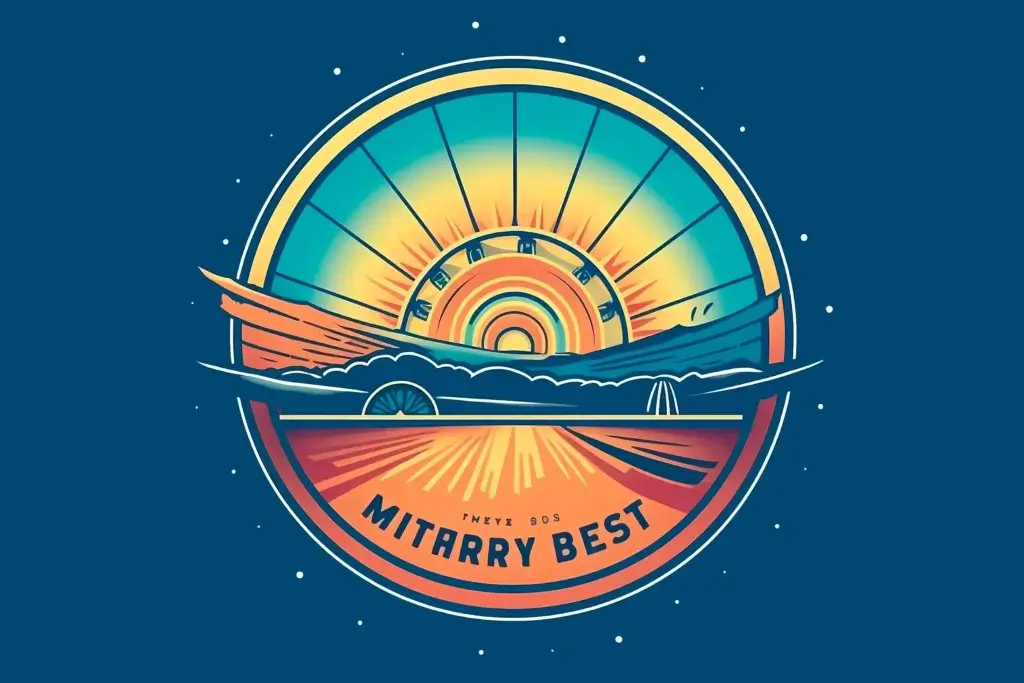
3. AI will also play an even bigger role in how social media content is delivered
In 2023, we started seeing Facebook and Instagram shift how their feeds deliver content to users, prioritizing more recommended content than content from people they actively follow. This is good news for destinations, allowing them to more easily reach new social media users and increase their brand awareness organically where they might typically have to rely on paid ads.
In 2025, we’ll likely see AI take even more control over what content is delivered to users to maximize their engagement with the platform–anything to keep them on the platforms for as long as possible.
This means that the more content you have in the places people are spending the most time, the more likely people will have a chance to engage with it. And we know that the king of content right now is short-form video.
4. Short-form, UGC video continues to reign supreme
In the travel industry, videos have long been an indispensable marketing tool. They show off destinations and hospitality businesses in their full glory. Plus, it doesn’t hurt that 75% of Instagram users take action after viewing a video ad.
“Consumers, on average, spend about 323 minutes per week watching video content, and that is on mobile phones alone,” said Mackenzie Bromley, the Director of Social Media at MMGY Global.
We strongly encourage travel marketers to lean harder into short-form video content—and that doesn’t mean big-budget productions. Again, short, user-generated videos appeal to travelers looking for an unfiltered view of the destinations and experiences they’re researching. And with AI-driven algorithms pushing content based on a user’s interests and engagements, you’ll want to make sure that your brand has the video library needed to be able to be delivered anytime the opportunity arises.
5. Although they seem similar, each social media platform is still different and requires different strategies
“TikTok is not social media. It’s an entertainment platform,” said Beril Gutierrez, Senior Manager of Social Media at Discover The Palm Beaches.
Gutierrez says that TikTokers spend an average of 61 minutes per day on the app, which is 50% higher than platforms like Facebook and Instagram. Brands on TikTok have the opportunity to see higher engagement rates and keep audiences glued to their phones with entertaining content, and Instagram is quickly evolving to follow suit with Reels, as you’ll read below.
And it’s not all about Gen Z, either. About 23% of Gen X travelers have accounts on TikTok, so prepping a TikTok strategy for your destination could have a big payoff with multiple demographics itching to travel again.
The bottom line? Your social media marketing strategy can’t ignore TikTok’s audience of two billion (and counting). But you also can’t deprioritize Reels or YouTube Shorts, either.
If your state is experiencing government bans for TikTok, check out this blog post and our tips for working around them!
Instagram Travel Trends
Instagram’s impact on travel is still undeniable: according to CNBCTV18, a study by the World Tourism Organisation found that Instagram users are more likely to travel than non-users, and they are also more likely to spend more money on travel.
And “Instagrammable Places” is a popular search term for a reason: travelers love searching for that perfect vacation picture, whether a popular landmark or a hidden gem (that may not be so hidden after going viral)!
In terms of the platform itself, Instagram Reels are still having a moment: every Meta quarterly report shows Reels inching closer to a level playing field with its TikTok competitor, in both revenue and time spent on the app. Reels now boasts more than 200 billion plays per day across Instagram and Facebook, up from 140 billion in 2022.
Whether it’s the continued reach of short-form video, the novel tools and features for content creation, or the engaged and relevant user base, destination marketers should be making Instagram their top social priority.
And as Instagram continues to morph from social network to bonafide entertainment and e-commerce app, expect to see more experimental launches and rapid feature changes. Already the app is phasing out Guides, unveiling week-long Stories, and testing personality-driven chatbots, and ramping up Threads. We’ll definitely be seeing more AI developments, some copied over from Facebook, and possibly others that are unique to Instagram.
Want to learn more about how to create IG Reels for your DMO that turn lookers into bookers? Check out our eBook.
TikTok Travel Trends
Iconic skylines and picture-perfect backdrops continue to trend: the destinations with the most hashtags on TikTok include Dubai, New York City, London, and Paris. “So, whether you’re looking for desert glamor or big-city energy, TikTok users have already scouted the hottest destinations to round off your 2024 or inspire your 2025 #vacation,” says Antoinette Turner, Flight Centre South Africa’s general manager.
IOL also reports that travel-adjacent trends can also have a big impact on the industry, such as the #RomanEmpire meme resulting in increased Google searches, #SoftHiking highlighting a gentle and accessible approach to hikes, and #VacationPrep beauty routines leading up to a holiday getaway. Destination marketers shouldn’t be scared to experiment with memes and hop on social trends as a way of boosting reach and engagement!
And while TikTok is mostly known for its bite-sized videos, experts have noted that the popular app now seems to be encouraging long-form videos, too — likely to compete with YouTube. By encouraging the longer vlog- and infotainment-style content that has thrived on YouTube, TikTok can increase video watch times and time on the app — and nurture way more ad placements. Short-form video isn’t going anywhere, but to show up in a changing algorithm, destination marketers should browse their library of clips to test different video lengths.
Last but not least, TikTok Shop also launched in September 2023, allowing for a new e-commerce ecosystem including shoppable videos and a native shopping experience. We’ll keep our eyes peeled on how this new feature will transform viewers into consumers!
X (formerly known as Twitter)
According to our 2024 Trends report, only 3% of destination marketers thought X would be the most buzzworthy social media channel in 2024, and very few prioritized it in their 2024 marketing plans. Our survey showed 66% of destination marketers wish they could drop this channel from their content mix altogether, and we agree it probably won’t hurt to focus your efforts elsewhere in 2024.
As we look ahead to 2025, newer options like Threads and Bluesky are surging in popularity, with many users leaving X in search of a less politically-influenced platform.
6. More and more travel brands are working with content creators over influencer marketing
73% of brands actively use influencer campaigns as a powerful arm of their marketing machine, and there’s no doubt that trend is here to stay.
Often, we get stuck in the trap that expensive, big-name influencers = better ROI, but that’s not always the case. Micro-influencing can be just as, well, influential as working with content creators with a huge follower base.
Partner up with content creators who have a unique POV that aligns with your mission, rather than a mega-influencer whose content casts a super-wide net (we’re biased, but our solution, CrowdRiff Creators, is a game changer in this department!). For example, want to highlight Indigenous lands and experiences within your destination? Partner with Indigenous content creators. Looking to showcase your destination’s food scene? Work with a foodie micro-influencer who already lives, breathes, and eats in your community.
Your brand is more than just your owned channels. The best-performing content is when content creators tag you in their content.
7. Social media marketing analytics are more important than ever
Year after year, the need for insightful analytics grows. At-a-glance dashboards can be overwhelming at first, but the exciting part about raw data is that, eventually, that data becomes a story. Here are a few things you should keep a pulse on when you’re looking at social media analytics:
- Engagement rate. How are people engaging with your content? Are they watching, commenting, saving, and sharing, or merely scrolling past? If you have a million followers but only 1,000 of them actually interact with your marketing, that’s not a great return on your effort. The average engagement rate for travel, hospitality, and leisure accounts is 1.73% according to Hootsuite.
- Reach & impressions. How many new eyeballs are your accounts reaching week over week or month over month, and is this number stagnant or growing? Short-form video for Reels, Shorts, and TikTok are the best way to reach new audiences on these platforms, which is why short-form video is critical in any content marketing strategy.
- Video views and video retention rates: Over the last few years, marketers have watched engagement rates drop year over year, despite audience growth. It seemed like fewer platform users were going out of their way to like, comment, and share content, and the platforms needed a new way to measure engagement. Thanks to Reels, TikToks, and YouTube Shorts, platform users are spending more time on the platform and engaging with content just by watching it. So while content actions might be falling, you’re still able to measure how captivating your content is using these metrics. And arguably, content consumption matters more for DMOs than content actions like likes, comments, and shares.
So to summarize, follower counts and engagement rates are only a small piece of the puzzle when it comes to measuring your social media marketing performance. In order to get the whole story, you’ll want to consider all the metrics that are available on TikTok, Instagram, Facebook and Youtube Shorts, especially short-form video performance.
8. Tapping into current trending social media content will amplify your reach
By now, you’ve likely encountered at least one trending Reel or TikTok template. In 2023, Barbie, Pedro Pascal, Taylor Swift, and cats ruled social media feeds, and brands that tapped into these trends were reaching audiences in new and creative ways. Trends like these sparked engagement and reached users in ways conventional posting is rarely able to.
But tapping into social trends takes creativity and agility. The good news is, there are plenty of apps that are free or reasonably priced that provide trendy templates. They make it easy to import your visuals, leverage the template, and then export your short-form video across your social media channels.
Want to find out how you can harness social trends in your destination’s marketing strategy? Check out our recent webinar about How Your Destination Can Tap Into Social Trends.
Conclusion: What are the social media content trends in 2025?
There are dozens of touch points on social media that your digital marketing strategy can leverage to get people hyped about your destination—like entertaining videos on TikTok, or powering your paid ads with authentic UGC that makes potential travelers feel like they’re already there.
Some marketing trends have staying power, but remember: you know your audience better than anyone. Take inventory of your best-performing social content in 2024 and use that as inspo while you’re prepping for 2025.
Unlock the 2025 content calendar
